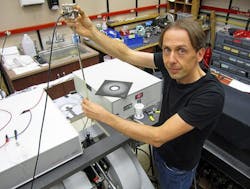Spintronics could improve OLED device efficiency
A study published in Science brings physics a step closer to practical machines that work "spintronically" as well as electronically: superfast quantum computers, more compact data storage devices, and organic light-emitting diodes or OLEDs that are more efficient than those used today. University of Utah physicists read the subatomic "spins" in the nuclei of hydrogen isotopes and used the data to control current that powered light in a cheap, plastic LED—at room temperature and without strong magnetic fields.
RELATED ARTICLE: Utah, Israeli physicists invent spintronic LED
"We have shown we can use room-temperature, plastic electronic devices that allow us to see the orientation of the tiniest magnets in nature—the spins in the smallest atomic nuclei," says physics professor Christoph Boehme, one of the study's principal authors. "This is a step that may lead to new ways to store information, produce better displays and make faster computers."
The experiment is a much more practical version of a study Boehme and colleagues published in Science in 2010, when they were able to read nuclear spins from phosphorus atoms in a conventional silicon semiconductor. But they could only do so when the apparatus was chilled to minus 453.9 degrees Fahrenheit (nearly absolute zero), was bombarded with intense microwaves and exposed to superstrong magnetic fields.
In the new experiments, the physicists were able to read the nuclear spins of two isotopes of hydrogen: a single proton and deuterium, which is a proton, neutron and electron. The isotopes were embedded in an inexpensive plastic polymer or organic semiconductor named MEH-PPV, an OLED that glows orange when current flows. The researchers flipped the spins of the hydrogen nuclei to control electrical current flowing though the OLED, making the current stronger or weaker. They did it at room temperature and without powerful light bombardment or magnetic fields—in other words, at normal operating conditions for most electronic devices, Boehme says.
Harnessing nuclear spins can increase the efficiency "of electronic materials out of which so much technology is made," Boehme adds. "It also raises the question whether this effect can be used for technological applications such as computer chips that use nuclear spins as memory and our method as a way to read the spins."
In spintronics, data are stored by the spins of either electrons or, preferably, atomic nuclei. Spin often is compared with a tiny bar magnet like a compass needle, either pointing up or down—representing one or zero—in an electron or an atom’s nucleus. Nuclear spin orientations live longer, so are better for storing data.
In the new experiments, the physicists used magnetic resonance to reverse the nuclear spins in hydrogen isotopes embedded in the OLED, and then were able to detect how the reversed spins caused a change in the electrical current through the OLED. "If you want to store information, the highest storage density would be to store information in single nuclear spins," Boehme says. Since the 2010 study, other physicists have achieved that in phosphorus nuclei, he adds.
By storing information using both spins and electrical charge, spintronic devices should have greater storage capacity and process data more quickly—although researchers still have years to go to figure out how to connect and process spintronically stored information in futuristic computers, conventional and quantum.
"We don't know if its five years, 50 years or never," Boehme says. Yet he says spintronics already resulted in today's terabyte-sized computer hard drives, which use spintronic "read heads" so small that data can be stored more densely. "Hopefully, OLEDs will become better—use less electricity and produce more light—because we learned here how nuclear spins’ orientation influences how well the OLED works," Boehme says. "Any sort of efficiency limitation can only be overcome if the mechanism that imposes this limitation is understood."
SOURCE: University of Utah; http://unews.utah.edu/news_releases/nuclear-spins-control-current-in-plastic-led/
About the Author

Gail Overton
Senior Editor (2004-2020)
Gail has more than 30 years of engineering, marketing, product management, and editorial experience in the photonics and optical communications industry. Before joining the staff at Laser Focus World in 2004, she held many product management and product marketing roles in the fiber-optics industry, most notably at Hughes (El Segundo, CA), GTE Labs (Waltham, MA), Corning (Corning, NY), Photon Kinetics (Beaverton, OR), and Newport Corporation (Irvine, CA). During her marketing career, Gail published articles in WDM Solutions and Sensors magazine and traveled internationally to conduct product and sales training. Gail received her BS degree in physics, with an emphasis in optics, from San Diego State University in San Diego, CA in May 1986.
